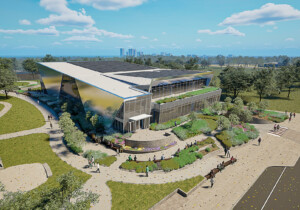Though only one semester had elapsed since the student-designed and fabricated FIBERwave carbon fiber pavilion went up, by early 2015 IIT professor Alphonso Peluso was hungry for more.
For his Digital Fabrication seminar this spring, Peluso upped the architectural ante, asking students to think in terms of a facade panel system rather than a freestanding structure. “It seemed like if we wanted to be taken seriously, we’d have to [focus on] a real-world application,” he explained. With support from a number of outside experts, Peluso and his students designed and built a full-scale panel segment in a single semester. Beyond demonstrating the capacity of carbon fiber to function as a building skin, CARBONskin evidences the synergetic power of curiosity backed by experience.
“The big story” behind CARBONskin, said Peluso, is the network of designers and fabricators he has become a part of since FIBERwave. Thanks to interest generated by the pavilion, several sponsors have donated materials. “Now we can keep moving forward,” said Peluso. “I wasn’t sure, because the crowdfunding thing is too difficult to do over and over.”
In addition, several leading lights in the field of carbon fiber architecture have offered technical assistance. Kreysler & Associates consulted on both FIBERwave and CARBONskin. And Greg Lynn, whose previous experiments with carbon fiber (including his RV PROTOTYPE House) served as models for CARBONskin, also shared information and advice. Lynn “has been a real inspiration for me and my students,” said Peluso. “He’s really ahead of the curve.”
Before tackling the facade panel design, the seminar enrollees—Carlos Davalos, Pablo Ferrer Franco, Jacob Harney, Raleigh Howard, Zhitao Hu, Zachary Jaffe-Notier, Aishwarya Keshav, Bowen Lu, Caio Mendonca Placido, Mina Rezaeian, and Eric Schwartzbach—gained early exposure to carbon fiber in a seasonally appropriate exercise. Knowing that students enjoy fabricating at full scale, and deciding to take advantage of the particularly cold weather, Peluso tasked the students with designing ice structures in the vein of Heinz Isler.
“I saw a connection between ice structures and carbon fiber,” he recalled. “With carbon fiber, you work with cloth, and use chemicals to make it structural. I thought, ‘Why not use water instead, and harden the cloth into ice?'” Because the forms involved hanging cloth over supports, moreover, the students could start working with carbon fiber immediately, building small-scale prototypes of their ice structures without first completing a tutorial in CNC milling or molding techniques.
Soon, however, it was time to shift focus to the facade system itself, which would be applied to a disused two-story curtain wall mockup on the IIT campus. Working in groups, the students designed and fabricated scale carbon fiber models of four facade panels. At midterm, they presented their designs to Polynt Composites‘ Rick Pauer. (Peluso and Pauer first met through the comments section in an AN article on FIBERwave.) Both Pauer’s critique and the students’ own experience were instrumental in determining a final panel configuration, which the class voted on after a design charrette.
“When they make these small-scale models, they start to run into a lot of challenges; they start to understand the capabilities of carbon fiber,” explained Peluso. “They use that as a feedback loop, and make adjustments based on the actual process of working with the material.”
Featuring a complicated topography of hills and dips punctuated by amorphous PETG windows, the design the students selected was the most complex of the those produced during the charrette. “It was exciting and intimidating at the same time,” recalled Peluso. “But that’s where the best projects come from, in general—people who are willing to just go for it.”
Meanwhile, a number of industry sponsors had volunteered to donate materials. But with the semester flying by and none of the promised supplies yet on hand, Peluso made a tough decision: he purchased (at a discount) enough cloth from Soller Composites to build three feet of the 9-foot-11-inch-tall panel at full width. (Peluso and his summer students will use material since delivered by Hexcel and Vectorply to fabricate a full-scale panel.)
To work around another challenge—the fact that the molds were too large for the school’s vacuum former—Peluso called on Matt Locaciato of Fiberworks. Locaciato showed the class how to use a Duratec primer (donated by Composites One) to prevent the carbon fiber from sticking to the CNC-milled wood molds. “It was our first time using the primer and it worked,” said Peluso. “It was one of those magical things.” The rest of the fabrication process, which involved curing the carbon fiber with West Systems epoxy resin, releasing it from the mold, CNC-trimming the panel to size, and finishing with several applications of a Duratec top coat, went smoothly.
Given the speed with which a single semester passes and the nature of the course—a seminar rather than a studio—the fact that Peluso and his students completed one-third of a full-scale panel before the summer break is itself remarkable. For Peluso, the crowning achievement was the collective pride the project engendered. At the beginning of the term, he said, “I didn’t really know what the outcome would be. When you have students in studio, you can count on them for a lot of hours. For an elective, they don’t put in that kind of time.” But by the time they joined Locaciato in the shop to prime the molds, all of the enrollees were fully committed. “At that point, the students started to become really excited about full-scale fabrication with this exotic material—you started seeing them more,” recalled Peluso. “I think that’s the coolest thing [about this experience]. The success is that these students came together.”










